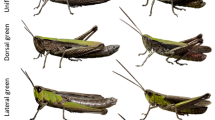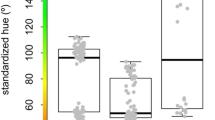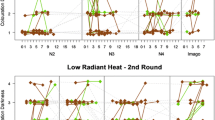Abstract
Color polymorphisms in animals may result from plasticity of the developmental system in response to genetic cues in the form of allelic variation at polymorphic loci, environmental cues, or a combination of genetic and environmental cues. An increased understanding of the evolution of color polymorphisms requires better knowledge of when we should expect genetic and environmental cues respectively to influence phenotype determination. Theory posits that the developmental systems of organisms should evolve sensitivity to such cues that most accurately predict coming selective conditions. Pygmy grasshoppers (Orthoptera, Tetrigidae) vary in color pattern within and among populations and show fire melanism, i.e., an increased frequency of black and dark colored phenotypes in high density populations inhabiting fire-ravaged areas. We examined if the population density experienced by individuals during development influenced the phenotypic expression of color pattern in Tetrix subulata. Individuals were experimentally reared either in solitude, at intermediate density or under crowded conditions. We found that color patterns of experimental individuals were independent of rearing density but strongly influenced by maternal color pattern. High population density and crowding may not constitute reliable predictors of the selective regime that characterizes post-fire environments.

Similar content being viewed by others
References
Ahnesjö J, Forsman A (2003) Correlated evolution of colour pattern and body size in polymorphic pygmy grasshoppers, Tetrix undulata. J Evol Biol 16:1308–1318
Ahnesjö J, Forsman A (2006) Differential habitat selection by pygmy grasshopper color morphs; interactive effects of temperature and predator avoidance. Evol Ecol 20:235–257
Anstey ML, Rogers SM, Ott SR, Burrows M, Simpson SJ (2009) Serotonin mediates behavioral gregarization underlying swarm formation in desert locusts. Science 323:627–630
Bishop YMM, Fienberg SE, Holland PW (1974) Discrete multivariate analysis: theory and practice. M.I.T. Press, Cambridge
Caesar S, Ahnesjö J, Forsman A (2007) Testing the role of co-adapted genes versus bet hedging for mating strategies in colour polymorphic pygmy grasshoppers. Biol J Linn Soc 90:491–499
Caesar S, Karlsson M, Forsman A (2010) Diversity and relatedness enhance survival in colour polymorphic grasshoppers. PLoS ONE 5:e10880
Cott HB (1940) Adaptive coloration in animals. Methuen and Co., London
Dearn JM (1990) Biology of grasshoppers. Wiley, New York
Edelaar P, Siepielski AM, Clobert J (2008) Perspective—matching habitat choice causes directed gene flow: a neglected dimension in evolution and ecology. Evolution 62:2462–2472
Fisher RA (1939) Selective forces in wild populations of Paratettix texanus. Ann Eugen 9:109–122
Ford EB (1945) Polymorphism. Biol Rev 20:73–88
Forsman A (1999) Variation in thermal sensitivity of performance among colour morphs of a pygmy grasshopper. J Evol Biol 12:869–878
Forsman A (2000) Some like it hot: intra-population variation in behavioral thermoregulation in color-polymorphic pygmy grasshoppers. Evol Ecol 14:25–38
Forsman A, Appelqvist S (1999) Experimental manipulation reveals differential effects of colour pattern on survival in male and female pygmy grasshoppers. J Evol Biol 12:391–401
Forsman A, Ringblom K, Civantos E, Ahnesjö J (2002) Coevolution of color pattern and thermoregulatory behavior in polymorphic pygmy grasshoppers Tetrix undulata. Evolution 56:349–360
Hochkirch A, Depperman J, Gröning J (2008) Phenotypic plasticity in insects: the effects of substrate colour on the colouration of two ground-hopper species. Evol Dev 10:350–359
Hocking B (1964) Fire melanism in some African grasshoppers. Evolution 18:332–335
Holst KT (1986) The Saltatoria of Northern Europe. Fauna Entomol Scand 16:1–127
Kalmus H (1941) The resistance to desiccation of Drospophila mutants affecting body colour. Proc R Soc Lond B 130:185–201
Karlsson M, Caesar S, Ahnesjö J, Forsman A (2008) Dynamics of colour polymorphism in changing environments: fire melanism and then what? Oecologia 154:715–724
Karlsson M, Johansson J, Caesar S, Forsman A (2009) No evidence for developmental plasticity of color patterns in response to rearing substrate in pygmy grasshoppers. Can J Zool 87:1044–1051
Leimar O (2005) The evolution of phenotypic polymorphism: randomized strategies versus evolutionary branching. Am Nat 165:669–681
Leimar O (2009) Environmental and genetic cues in the evolution of phenotypic plasticity. Evol Ecol 23:125–135
Lester RL, Grach C, Pener MP, Simpson SJ (2005) Stimuli inducing gregarious colouration and behaviour in nymphs of Schistocera gregaria. J Insect Phys 51:737–747
Majerus MEN (1998) Melanism: evolution in action. Oxford University Press, Oxford
Meyers LA, Bull JJ (2002) Fighting change with change: adaptive variation in an uncertain world. Trends Ecol Evol 17:551–557
Miner BG, Sultan SE, Morgan SG, Padilla DK, Relyea RA (2005) Ecological consequences of phenotypic plasticity. Trends Ecol Evol 20:685–692
Moran NA (1992) The evolutionary maintenance of alternative phenotypes. Am Nat 139:971–989
Nabours RK (1929) The genetics of the Tettigidae. Bibl Genet 5:27–104
Pigliucci M (2001) Phenotypic plasticity: beyond nature and nurture. John Hopkins University Press, Baltimore
Pigliucci M, Preston K (2004) Phenotypic integration: studying the ecology and evolution of complex phenotypes. Oxford University Press, Oxford
Protas ME, Patel NH (2008) Evolution of coloration patterns. Ann Rev Cell Dev Biol 24:425–446
Roff DA (1996) The evolution of threshold traits in animals. Quart Rev Biol 71:3–35
Rowell CHF (1971) The variable coloration of the Acridoid grasshoppers. Adv Insect Phys 8:145–198
Ruxton GD, Sherratt TN, Speed M (2004) Avoiding attack the evolutionary ecology of crypsis, warning signals and mimicry. Oxford University Press, Oxford
SAS (2004) SAS 9.1.3 Help and documentation. SAS Institute, Cary
Simpson SJ, Sword GA, De Loof A (2005) Advances, controversies and concensus in locust phase polyphenism. J Orthopt Res 14:213–222
Sokal RS, Rohlf FJ (1981) Biometry, 2nd edn. Freeman, New York
Stearns SJ (1989) The evolutionary significance of phenotypic plasticity—phenotypic sources of variation among organisms can be described by developmental switches and reaction norms. Bioscience 39:436–445
Sword GA (1999) Density-dependent warning coloration. Nature 397:217
West-Eberhard M (2003) Developmental plasticity and evolution. Oxford University Press, Oxford
Wittkopp PJ, Beldade P (2009) Development and evolution of insect pigmentation: genetic mechanisms and the potential consequences of pleiotropy. Semin Cell Dev Biol 20:65–71
Acknowledgments
We thank S. Caesar, M. Forsman and C. Kindblom for assistance with experimental cages and maintenance of experimental animals. Comments by L. Wennersten and two anonymous reviewers helped improve the manuscript. The Swedish Science Council, The Swedish Research Council Formas, the University of Kalmar and Linnaeus University (grants to A.F.) provided financial support.
Author information
Authors and Affiliations
Corresponding author
Rights and permissions
About this article
Cite this article
Karlsson, M., Forsman, A. Is melanism in pygmy grasshoppers induced by crowding?. Evol Ecol 24, 975–983 (2010). https://doi.org/10.1007/s10682-010-9399-9
Received:
Accepted:
Published:
Issue Date:
DOI: https://doi.org/10.1007/s10682-010-9399-9




